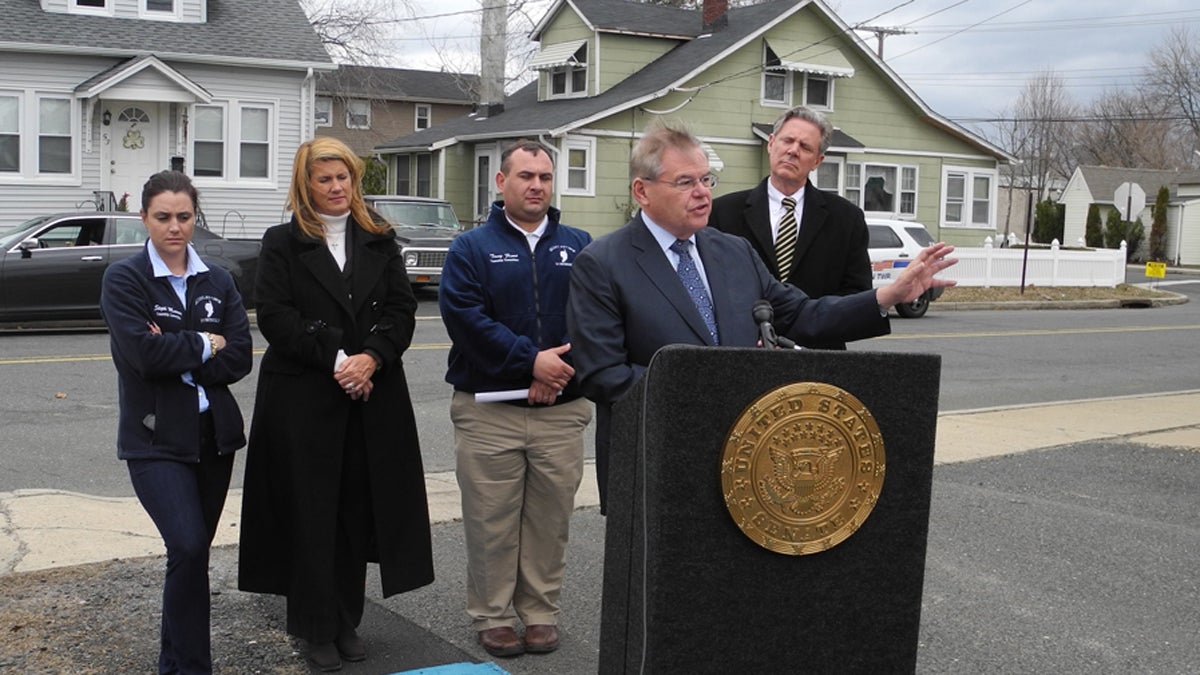New flood insurance law brings relief, questions to Jersey Shore
Listen
From left, Middletown Mayor Stephanie Murray, Monmouth County Freeholder Serena DiMaso, Middletown Township Committee member Tony Fiore, Sen. Bob Menendez (D-NJ), New Jersey Congressman Frank Pallone (D-N76). (Tracey Samuelson/for NewsWorks)
After President Obama signed the Homeowner Flood Insurance Affordability Act, many Jersey Shore homeowners and state politicians are celebrating a small piece of good news in a long, slow recovery from Superstorm Sandy.
“I believe relief is on the way,” Sen. Bob Menendez (D-N.J.) said Friday, at an event in Middletown, touting the law he sponsored. “Many have been spared from making the difficult choice between paying for flood insurance and paying for their mortgage.”
However, many residents are now wondering how long it will take to see the legislation’s promised benefits and questioning how effective it will be at preventing local property values from sinking.
Limits on annual increases
The new law caps flood insurance rate increases at 18 percent per year with a new $25 annual fee for primary homeowners. Owners of second homes, businesses, and properties that have had substantial flood damage will see rate increases of up to 25 percent, with a $250 annual fee.
This allows for implementing changes to the National Flood Insurance Program that Congress passed in 2012 more slowly. That law is known as the Biggert-Waters Act. It sought to phase out flood insurance subsidies, pushing policyholders to pay rates that reflect their true risk of flooding.
As Biggert-Waters began to take effect late last year, homeowners worried that rising flood insurance premiums, combined with expensive repairs from Sandy, would price them out of their homes. They also feared the changes would make their properties unappealing to buyers who might be cautious about purchasing homes that require pricy insurance policies.
With the passage of the Homeowner Flood Insurance Affordability Act, some shore residents are feeling relief that their rates won’t immediately skyrocket.
“We were paying roughly $1,700 in insurance prior to the storm,” said Port Monmouth resident Maria Benbrook. “Two days before the renewal date is up, I get a letter that $7,400 and change. I said, ‘excuse me?’”
Benbrook is hoping that the new law resets her rates and refunds the portion of the increased premiums that she’s already paid.
But just when those refunds might come or how long it will take for homeowners to get their new lower rates is fuzzy.
Unclear timeline
There isn’t yet a timeline to implement new rates or refunds, according to FEMA Administrator Craig Fugate, who testified before U.S. House of Representatives committee earlier this week.
Fugate described the complicated progress of setting new rate procedures with the private insurance companies that administer policies for the NFIP. He said he wasn’t yet sure whether those companies’ fees, which are collected as a percentage of premiums, would also be refunded.
Menendez said Friday that he hoped the law’s changes would be implemented within two months.
Lingering real estate concerns
Under Biggert-Waters, flood insurance rates would immediately lose all subsidies when a property was sold. That provision was repealed with the Homeowner Flood Insurance Affordability Act and affected homeowners will see refunds for any higher rates that have already taken effect.
Moreover, because insurance premiums will still rise – just more slowly than under previous legislation – real estate markets in flood zones may still take a hit.
“Would you buy a home where the flood insurance was a $1,000 a year and going to go up to $20,000 a year?” asked Toms River resident George Kasimos, the founder of a grassroots group called Stop FEMA Now, which campaigned for the new law. “Whether it goes up in five years or 20 years, you’re going to know this and you’re not going to buy that house.”
Both Kasimos and Menendez are hoping to address lasting affordability concerns in 2017, when the National Flood Insurance Program will need to be reauthorized by Congress.
“That’s when we’re going to have to make permanent and more substantial changes,” Kasimos said.
WHYY is your source for fact-based, in-depth journalism and information. As a nonprofit organization, we rely on financial support from readers like you. Please give today.




